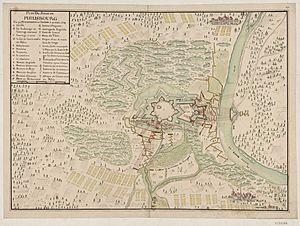Siege of Philippsburg (1688) facts for kids
Quick facts for kids Siege of Philippsburg |
|||||||
|---|---|---|---|---|---|---|---|
| Part of the Nine Years' War | |||||||
 |
|||||||
|
|||||||
| Belligerents | |||||||
| Commanders and leaders | |||||||
|
|||||||
| Strength | |||||||
| 30 000–40 000 men 52 heavy guns 24 mortars |
2 000 men 17 battery guns 90 small guns |
||||||
| Casualties and losses | |||||||
| 587 dead 1,013 wounded |
600 casualties 124 artillery pieces captured |
||||||
Imagine a strong castle or city wall that an army tries to take over. This is called a siege. The Siege of Philippsburg was one such event. It happened in 1688 at a place called Philippsburg, which is now in Germany. This siege was a big part of a larger conflict known as the Nine Years' War.
The siege started on September 27, 1688, and lasted until October 30, 1688. It was a battle between the Kingdom of France and the Holy Roman Empire. In the end, the French army won, taking control of the fortress from the Imperial soldiers.
Contents
What Was the Siege of Philippsburg?
The Siege of Philippsburg was a military operation where the French army surrounded the fortress of Philippsburg. Their goal was to force the soldiers inside to surrender. A fortress is a very strong building or town designed to be defended easily.
This siege was a key event in the early days of the Nine Years' War. This war involved many powerful countries in Europe. They were fighting over who had the most power and control.
Why Was Philippsburg Important?
Philippsburg was a very important place because of its location. It was a strong fortress right on the Rhine River. This river was like a major highway for trade and armies in Europe.
Controlling Philippsburg meant controlling a key crossing point on the Rhine. It also allowed armies to move easily into different parts of Europe. This made it a valuable target for any country wanting to expand its power.
Who Was Involved in the Siege?
The main groups fighting were the Kingdom of France and the Holy Roman Empire. The Holy Roman Empire was a large group of states and kingdoms in central Europe.
- French Army: The French forces were led by important figures. These included Louis, Grand Dauphin, who was the son of the French king. Other leaders were the Duc de Duras and the famous military engineer Marquis de Vauban. Vauban was known for designing and attacking fortresses. The French had a very large army, with about 30,000 to 40,000 soldiers. They also had many powerful cannons and mortars.
- Imperial Garrison: The soldiers defending Philippsburg belonged to the Holy Roman Empire. Their commander was Maximilian von Starhemberg. They had a much smaller force, only about 2,000 men. They also had fewer and smaller guns compared to the French.
How Did the Siege Happen?
The French army arrived at Philippsburg in late September 1688. They quickly surrounded the fortress. Their plan was to cut off all supplies and help from reaching the defenders.
Vauban, the French engineer, was very skilled at sieges. He directed his soldiers to dig trenches closer and closer to the fortress walls. These trenches protected the attackers from enemy fire. They also allowed them to bring their cannons closer to the walls.
The French cannons then began to bombard the fortress. This meant they fired many heavy cannonballs at the walls to break them down. The defenders inside fought bravely, trying to stop the French advance. However, with their smaller numbers and fewer weapons, it was a very difficult fight.
The Defenders' Struggle
The Imperial soldiers inside Philippsburg faced constant attacks. They had to deal with the heavy cannon fire and the French army slowly getting closer. Life inside a besieged fortress was very tough. Supplies would run low, and soldiers would get tired and injured.
Despite their efforts, the walls of Philippsburg began to crumble under the French attack. The French were determined to take the fortress.
What Was the Outcome?
After more than a month of fighting, the Imperial garrison could no longer hold out. On October 30, 1688, they surrendered to the French army. This meant the French had won the siege.
The French victory at Philippsburg was important. It gave them control of a key strategic point on the Rhine River. This early success helped France in the beginning of the Nine Years' War.
- French Losses: The French army lost 587 soldiers who died and 1,013 who were wounded during the siege.
- Imperial Losses: The Imperial defenders had about 600 casualties (killed or wounded). The French also captured 124 of their artillery pieces.
The Siege of Philippsburg showed the power of the French army and the skill of their military engineers like Vauban. It was a significant moment in the history of the Nine Years' War.

